Manitoba Insect & Disease Update
Issue 10: July 26, 2017
Summary
Insects:
Diamondback moth is above economic threshold in some fields, and insecticide applications are occurring. Economic populations have been reported from the southwest and Gladstone areas.
Aphids have been a concern in some cereal fields. Soybean aphids can now be found in many fields. They are generally well below the economic threshold, but some higher populations do exist. A field in the Portage la Prairie area had economic levels reported.
Green cloverworm is being found in some soybean fields in the eastern part of Manitoba, but just at low levels.
Thistle caterpillars have been turning to pupae and adult butterflies, and levels of larvae have decreased.
Pathogens:
Goss's wilt symptoms have been observed in corn in the Austin area.
Barley yellow dwarf virus is a current concern in oat fields around the province.
Goss's Wilt
Goss's wilt symptoms are beginning to show up in corn around the province. The picture below was submitted from the Austin area. Typical early symptoms of Goss's wilt include tan/grey coloured discolouration starting around the leaf margins. The edges of the discoloured areas may appear water-soaked. A freckling pattern may also be evident in association with the other symptoms. The affected areas can appear shiny in the direct sunlight. This sheen is a result of the exudate released by the bacterial causal agent. Fungicides are not effective against Goss's wilt as it is caused by a bacterium. The disease survives on the crop residue, so residue management can help prevent the spread of the disease. The disease can also be managed through rotation and the selection of resistant/tolerant hybrids.
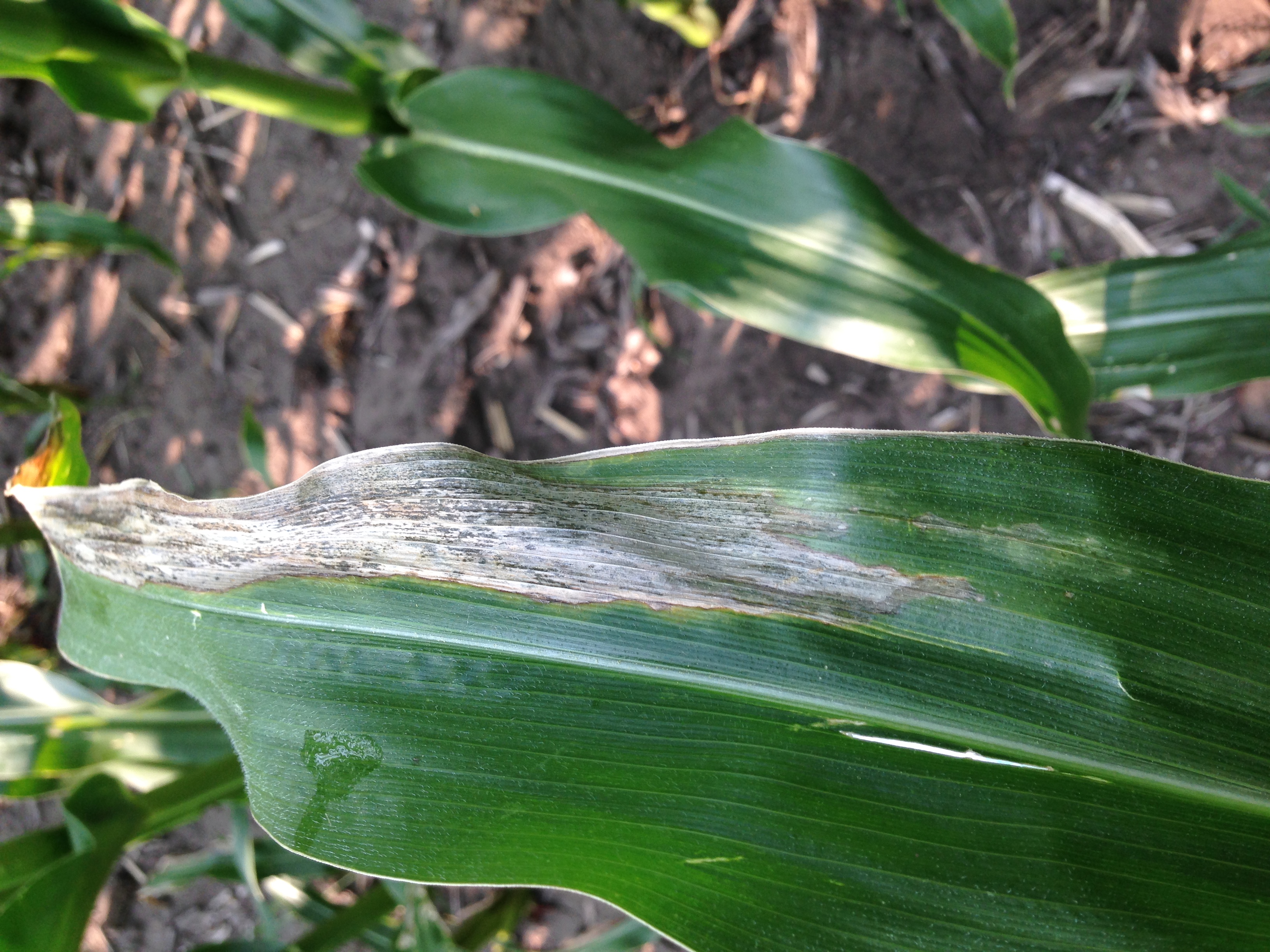
Figure 1. Photo: Amber Knaggs, Munro Farm Supplies
Barley Yellow Dwarf Virus
Multiple oat samples showing typical symptoms of barley yellow dwarf virus (BYDV) have been submitted. This disease shows up in patches in the fields and can be mistaken for early ripening symptoms. Early symptoms on leaves include chlorosis beginning of the leaf margins and tip and moving inward often leaving a green strip down the middle of the leaf. In oats, this chlorosis will often turn to a red/purplish colour. Severely infected plants may appear stunted and show blast symptoms (lack of florets and seed production). Oat varieties vary in their susceptibility to BYDV and ratings are indicated in Seed MB.
The only way this disease spreads is through aphid transmission. Several species of aphids may feed on wheat, but not all are equally good at vectoring this disease. The oat-birdcherry aphid, a dull olive-green aphid which is often on the stems and lower leaves, is a good vector of this disease. By comparison, the English grain aphid, a brighter green aphid which can often be found on the heads, is not as efficient a vector.
This disease can also affect other cereal crops like wheat and barley.
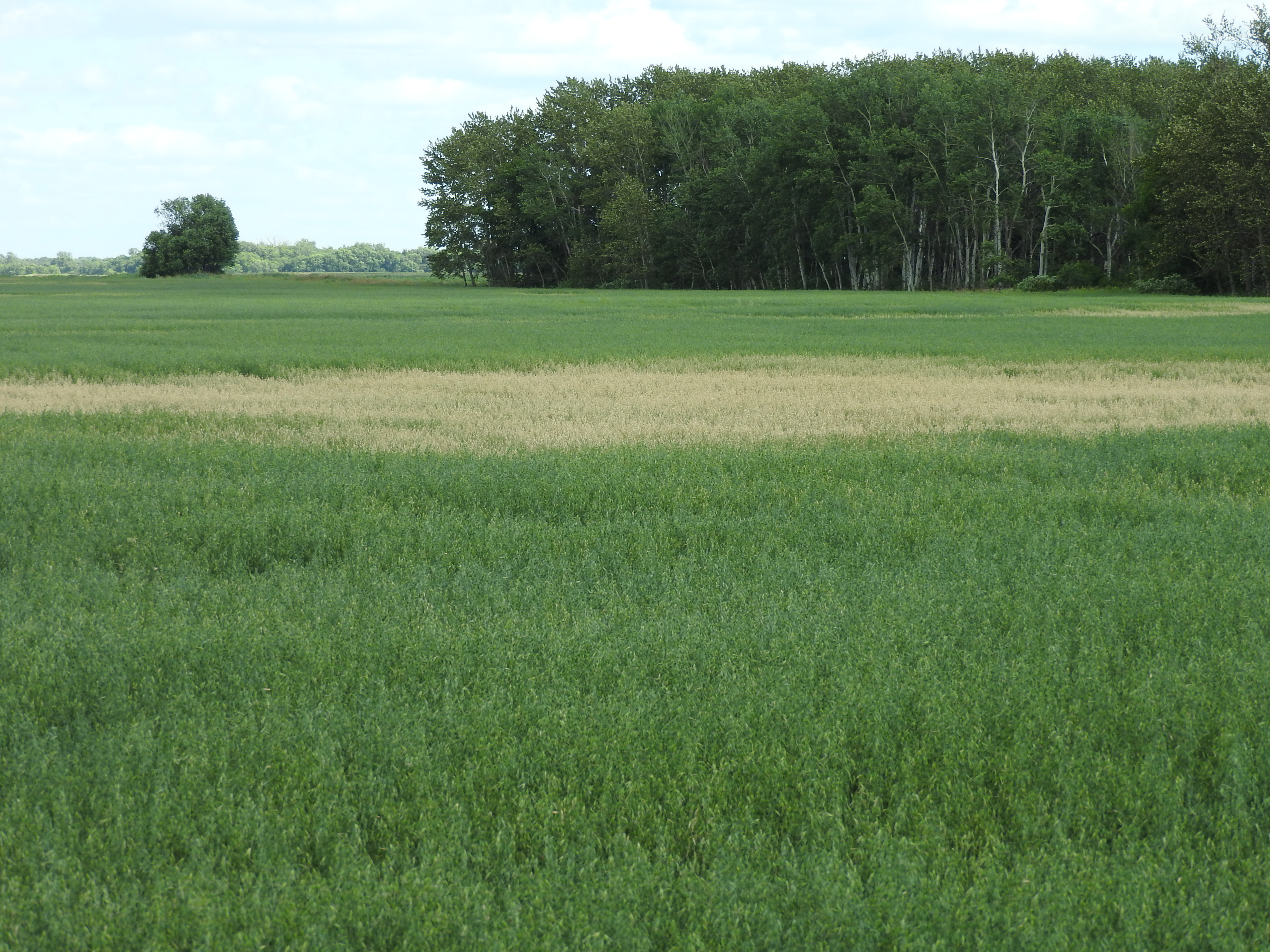
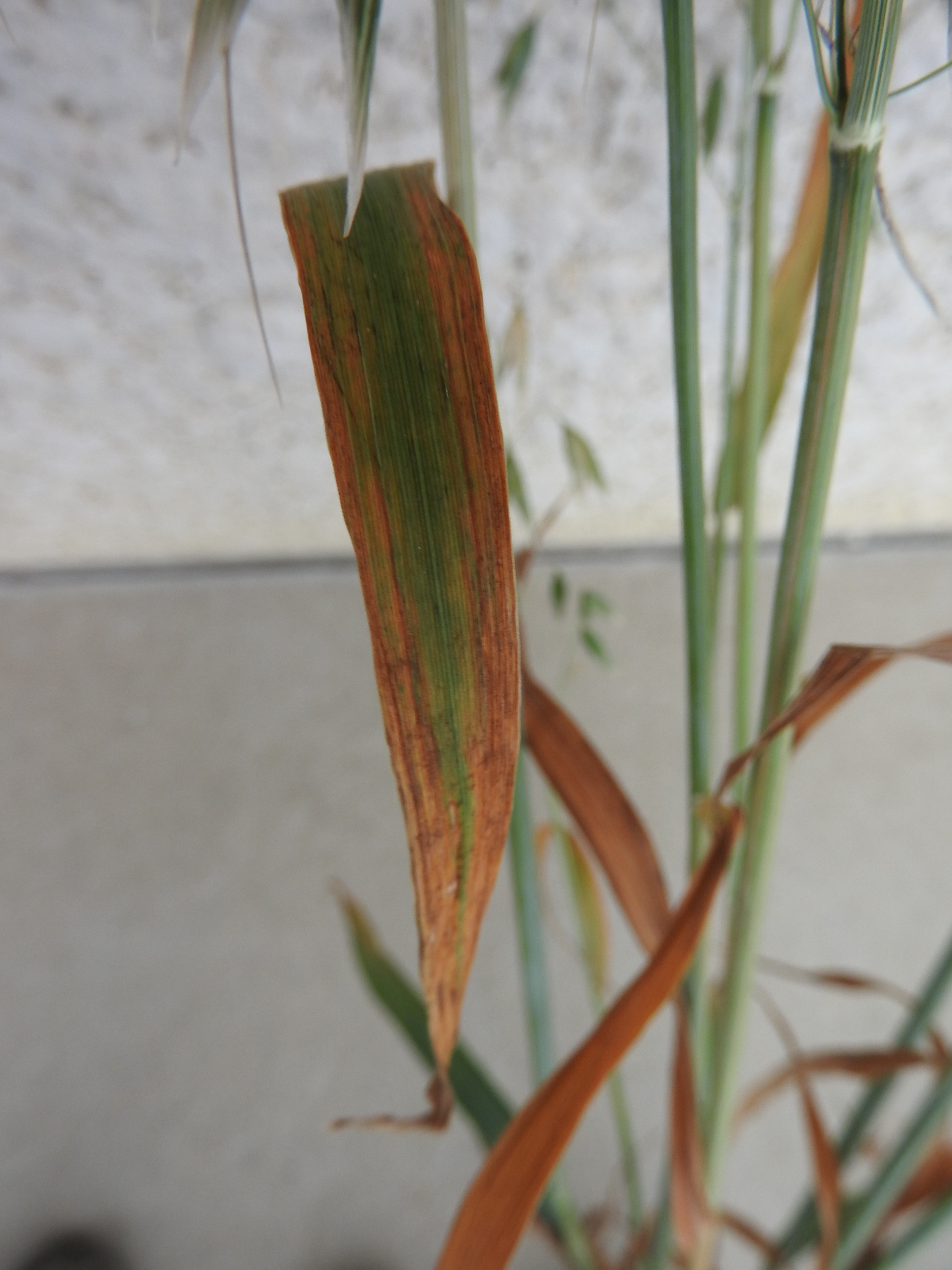
Figure 2. Figure 3.
Photos: Tracey Cummer, MB Ag
Diamondback Moth
Levels of diamondback moth have been above the threshold of 20 to 30 per square foot on average in some fields in the southwest and Gladstone areas. Some frequently asked questions are:
How long does it generally take to go through the larval stages? Temperature and food quality will affect rate of development, so the length of time as a larva can vary. Generally, the larval stages last about ten to 21 days. They will be in the pupal stage anywhere from 5 to 15 days.
How many generations a year to we get? Depending on temperature and food quality, it takes anywhere from 21 to 51 days to complete a generation. We can easily get 3 or 4 generations per year in Manitoba. Because they arrive over a long period, by this time of year generations are usually overlapping. I wouldn't be surprised if our current population was a mixture of 1st generation (newer arrivals), as well as second and third generation diamondback moth.
How long will they be damaging to canola: Diamondback moth will feed on the pods of canola, particularly when they are young. If soil moisture is sufficient, canola can compensate well for feeding to buds and flowers. The pod feeding is generally what can be most economical. If there is still leaf material they may prefer to feed on that. When leaves senesce, larvae may remove the surface tissue from the stems and seed pods. At times larvae may also chew into seed pods and eat the developing seeds. So if you are noticing pod feeding, do some counts of larval numbers per square foot and determine if there is still a population of larvae that could do further economical damage.
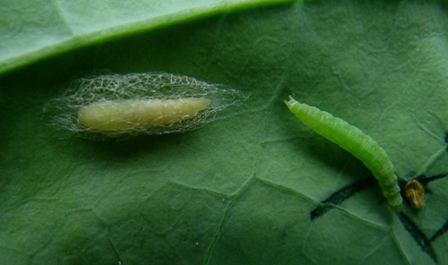
Figure 4. Pupa (left) and larva (right) of diamondback moth
How to monitor to make management decisions: You will often get a lot of diamondback moth larvae when sweeping a field. These counts unfortunately can not be used to make management decisions. I have known of instances where sweep net sampling resulted in up to about 100 larvae in 10 sweeps, yet counts on plants in a foot square resulting in levels well below the economic threshold. It is likely that crop staging will affect where the larvae prefer to be in the canopy, so what you get in a net is likely to be quite variable.
While sweeping may alert you to their presence, the suggested monitoring technique for decision making is to remove the plants in an area measuring 0.1 square metre (about 1 foot square), beating them on a clean surface, and counting the number of larvae dislodged from the plants. To obtain an accurate count, repeat this procedure in at least five locations in the field.
I have a beating sheet I sometimes take to the field that will sit on a denser canopy and plants can to shaken over. This is more practical than trying to take plants out of the field to assess. Something like an old cookie sheet or even stiff piece of cardboard may serve the same purpose, as long as it is not something that will get windborne on windier days.
What Threshold to Use? Thresholds for diamondback moth are nominal. This means they are based on experience rather than research quantifying the impact of the insect on the crop. The threshold used for podding canola is if larvae exceed 20-30 per ft2.
More Orange Butterflies
Last week we showed European skipper, a small orange butterfly that some have been seeing a lot of. There is another orange butterfly, considerably larger than European skipper, that many are now seeing. This is the painted lady butterfly (Vanessa cardui), which is the adult stage of the thistle caterpillar. They may be attracted to flowering crops for nectar, but will not be damaging these crops.
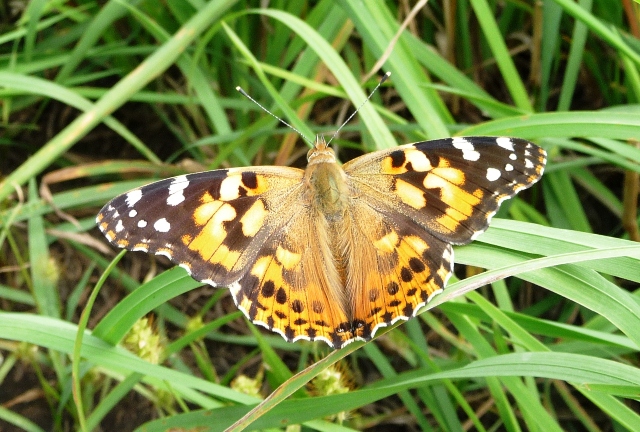
Figure 5. Painted lady butterfly.
Insect Monitoring Programs
Bertha Armyworm: Four traps from western Manitoba have cumulative counts for bertha armyworm in the uncertain risk range (300-900 moths). The other 86 traps are all in the low risk range (less than 300 moths). The highest concentrations of moths captured in the traps have been in the Benito and Durban areas in the Northwest.
Levels of larvae of bertha armyworm can vary greatly between fields within a region, and should higher levels of larvae occur in a region these higher levels of larvae may not be in the same fields as traps with the highest counts. This is due to the stage of the crop at the time of egg laying and other factors. Thus the data from these traps should not be used to make control decisions for bertha armyworm, but to encourage enhanced scouting for larvae in regions with higher trap counts.
Highest counts so far are:
Table 1. Highest cumulative trap counts for bertha armyworm adults over the trapping period June 4 to July 26, 2017.
0-300=low risk 300-900=uncertain risk 900-1,200=moderate risk 1,200+=high risk
| Location | Region | Count | Risk |
|---|---|---|---|
| Benito | Northwest | 479 | Uncertain |
| Tilston | Southwest | 379 | Uncertain |
| Durban | Northwest | 355 | Uncertain |
| Benito | Northwest | 319 | Uncertain |
| Benito | Northwest | 273 | Low |
| Durban | Northwest | 270 | Low |
| Napinka | Southwest | 267 | Low |
| Roblin | Northwest | 237 | Low |
| Pilot Mound | Central | 230 | Low |
A more detailed update of bertha armyworm counts in Manitoba is available on the Manitoba Agriculture website at: http://www.gov.mb.ca/agriculture/crops/insects/bertha-armyworm-forecast.html
For those monitoring trap, the traps can now be pulled. July 23 to 29th was the last week for data collection.
Insect Identification Quiz
These slug-like insects have recently been found in wheat heads, corn, and you will often see them on soybeans and many other crops. What are they?
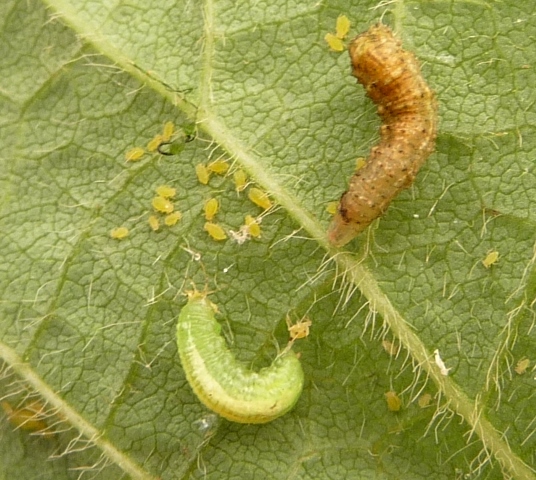
These are hover fly larvae.
I know they were part of last weeks quiz as well, but there have been quite a few enquiries about them recently. So good if crop scouts know what they are. And good that you are seeing so many of them in some of the cereal fields.
Hover fly larvae are legless and can't move between crops. But when the cereals start maturing and aphid populations on them declining the more mobile natural enemies may start moving to some of the later crops, such as soybeans, to find food. There is currently some very interesting research at the University of Manitoba studying this movement.
----------------------------------------------------------------------------------------------------------------------
Compiled by:
John Gavloski, Entomologist Holly Derksen, Field Crop Pathologist
Manitoba Agriculture Manitoba Agriculture
Phone: (204) 750-0594 Phone: (204) 750-4248
To report observations on insects or plant pathogens that may be of interest or importance to farmers and agronomists in Manitoba, please send messages to the above contacts.
To be placed on an E-mail list so you will be notified immediately when new Manitoba Insect and Disease Updates are posted, please contact John Gavloski at the address or numbers listed above.

